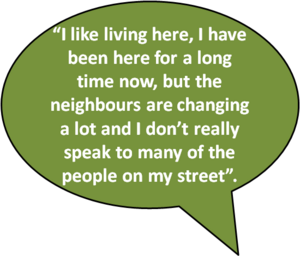Guided Conversations - Tips and Training
Guided Conversations can take many forms. However, key skills that need to be considered during the use of any Guided Conversation. Training sessions for individuals that will be conducting Guided Conversations are best when they take place in a comfortable and informal environment.
Before covering content on Guided Conversation skills, the team of individuals who are preparing to conduct Guided Conversations should get to know each other and think about the purpose of their specific Guided Conversation. In HAIRE, ageing was a key element of the Guided Conversation's purpose. A creative workshop, e.g. a simple poetry session, can help individuals share their thoughts and get to know each other. Guidance for a poetry session, compiled by Kelly Stevens, University of Exeter, can be seen here: [INSERT DOCUMENT].
The session linked to above covered the meaning of ageing, but this topic can be changed to any main interest that is relevant to a Guided Conversation.
For conducting Guided Conversations, the following skills can be covered in a training session.
Building Relationships
Guided Conversations have the potential to cover personal and sensitive experiences. Participants should feel comfortable with their environment and the individual that is conducting the conversation.
Before starting a Guided Conversation, it can be helpful to take the time to engage in general chat - talking about the weather or something positive that you notice about the person and/or wherever the Guided Conversation is taking place can help to create a more comfortable atmosphere.
Using creative prompts and asking questions
Guided Conversations allow individuals to talk about what matters to them, their opinions and experiences. To help, we recommend that open questions are used by individuals who are conducting the Guided Conversations. Open questions help in generating in-depth responses - typically, they begin with "how.." and "why.."
It is important that the first question asked is open and links to the Guided Conversation's main purpose. Creative prompts can be used at the start to help with conversation. In HAIRE's Guided Conversation, participants were shown the creative collages that were relevant to their local area and asked:
"How do you find living here? - this image [the creative prompt] might help you think about your local area."
This is when Active Listening becomes important. Active Listening is covered in more detail in the next section. Guided Conversations may have sub-topics of interest, but what the participant is saying should guide where the conversation goes next. Importantly, the sub-topics that a Guided Conversation contains should not be followed in order.
The moto is: Go where the participant take you! See example below:
Response to "how do you find living here?"
If included in a Guided Conversation as a sub-topic of interest, this response might lead to asking about someone’s identity and belonging or someone’s family and friends. There is no right way to go! The important skill is to build on what the participant is saying - either of the following questions can be asked to build on what the participant said:
Referenties
- Guidance for conversations around suicide and depression, Devon Mind, UK, Devon Mind, UK, 30 maart 2023.
- HAIRE Poetry Workshop Guidance, University of Exeter, University of Exeter, 30 maart 2023.



